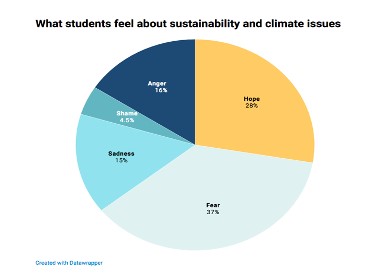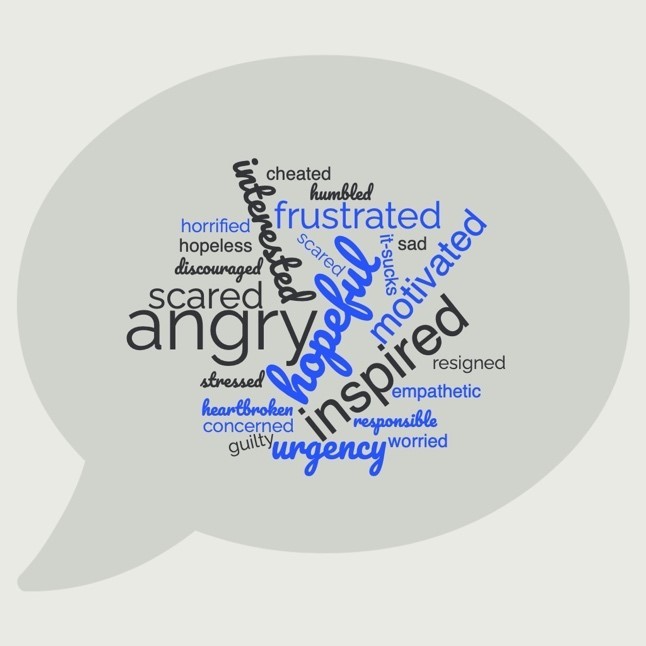I think the term climate anxiety really entered mainstream parlance with a Mother Jones article called It’s the End of the World as They Know It about how climate scientists feel based on what they witness every day: melting arctic ice, species loss, sea level rise, coral bleaching, fire.
Interestingly, the scientists showed almost the same range of emotions that we identified in our student research, which we labeled as fear, anger, sadness, shame, and hope.

Hiser and Lynch, 2022. (Based on group interviews with 300 college students in Hawai?i.)
The data was pretty simple. We just counted occurrences of emotion words in over 40 hours of transcribed interviews. Yet this pie chart really seemed to help teachers attend to the background emotions of their students, which of course is part of learning. A few other colleges, including Central College in Iowa, and Michigan State, replicated the study and found a similar spectrum of emotions.
I’ve been part of an international consortium working on a Toolkit for Climate Justice Educators which has some resources and activities, and a lot of interesting research and books about climate anxiety have come out recently (I’ll recommend two favorites at the end of this post).
But without getting into all the research, I see three ways to look at how we think about “climate anxiety” in mainstream conversations, and they are all important:
Diagnosable Anxiety
Let’s first look at anxiety as a diagnosable mental health condition. My fifteen-year-old daughter sees a therapist for Generalized Anxiety Disorder. Is that because of climate change? Probably, on some level, but there are so many other things causing anxiety in young people right now. Her therapist focuses on metacognition and being able to retrain thought patterns, like noting when she is catastrophizing. Mental health professionals are definitely paying attention to this. But, how do you treat climate anxiety in traditional therapy, especially when this predicament is not going away anytime soon?
All the Feels
A second way to look at climate anxiety is as an umbrella term for the full spectrum of climate emotions. I was influenced by Renee Lertzman’s research on changes in the Great Lakes region, which revealed a sadness that she called Environmental Melancholia. I also like the term Solastalgia, coined in 2003 by Glenn Albrecht – a blend of solace and nostalgia. So much change is happening so quickly: not just climate related, but condo developments and population density and tree removals and species extinctions. We miss the places we knew as kids.
And our own kids don’t even realize what they’ve never known.
Climate anxiety comes from not being able to express these emotions. Emotions are meant to move through us, so when someone helps you to label fear or anger or sadness that you are feeling, then you can find an expression for it and it will change. This is part of the job that teachers are doing, and there are communities doing work like The Work That Reconnects and the Good Grief Network. This is different from going to therapy -- it’s something communities need to do together.
You can find the right action for the feeling – anger is great for rallies, but is it healthy for young people to stay in that protest space? Sadness can be expressed with art or music. Sometimes I listen to this song, Love in the Time of Coral Reefs by Ruth Mundy, and I just let myself feel that heartbreak. I know that it’s only going to last for three minutes and thirty-five seconds, and if I choose to feel sadness on purpose then it doesn’t catch me by surprise, like when I’m teaching or trying to give testimony at the legislature. Lots of teachers have told me that they have cried in their classrooms. You could make a climate anxiety playlist for sorrow and rage and despair and another one for urgency and hope and inspiration.
It’s helpful to feel these emotions in small doses and to express them with others – this was part of what we did at the recent IEC retreat at Grimes Farm near Marshalltown. Here’s an informal tally of the emotions expressed by participants in one exercise at the retreat.

One thing that really stood out to me, listening to the concerns of the IEC members and staff, was how frequently tension and lack of civility or kindness in the general culture was expressed. This is hard work. And as one participant said, “If we can’t address something ‘simple’ like nitrates in drinking water, then how can we take on climate change?”.
Another participant commented that it was helpful, in the retreat, to zoom out for a day – “I break everything down to small units, and there’s something comforting in these planetary cycles.” Another comment was that “The worst decisions are the ones made quickly, but that is the norm in this work…If you aren’t going ninety miles an hour and working weekends then you’re missing stuff.”
Climate Reality
These emotions and comments are all part of what we mean when we talk about climate anxiety. I’d just call this coping with climate reality. The truth is that we have exceeded so many of our planetary boundaries; there is more carbon in the atmosphere than at any time that humans have ever experienced, with tipping points that we don’t understand. We are in totally uncharted territory. Our brains do not like this reality at all, so it creates some discomfort.
So how do we move forward?
Climate reality does NOT mean being a doomer or giving up or that it’s hopeless to do the work that IEC and its members do. Every single thing we do matters right now and for future generations. It’s just that our mind resists the actual reality of the situation, and that’s what I think we are feeling when we talk about climate anxiety.
It’s really just the brain’s problem with accepting our planetary predicament.
About the author
 Krista Hiser is a professor and the director of the Hawaii Center for Sustainability Across the Curriculum. She is a University of Iowa alumni, and along with a recent visit to the family farm, facilitated staff and member organization retreats for the Iowa Environmental Council on climate anxiety.
Krista Hiser is a professor and the director of the Hawaii Center for Sustainability Across the Curriculum. She is a University of Iowa alumni, and along with a recent visit to the family farm, facilitated staff and member organization retreats for the Iowa Environmental Council on climate anxiety.
Resources
Recommended books:
Video
We know the climate crisis and science can feel a bit overwhelming, so we invite you to take a pause to reflect, breathe, and honor the planet with some peaceful yoga created for Earth Day 2022 by IEC supporter Kasi Zieminski.